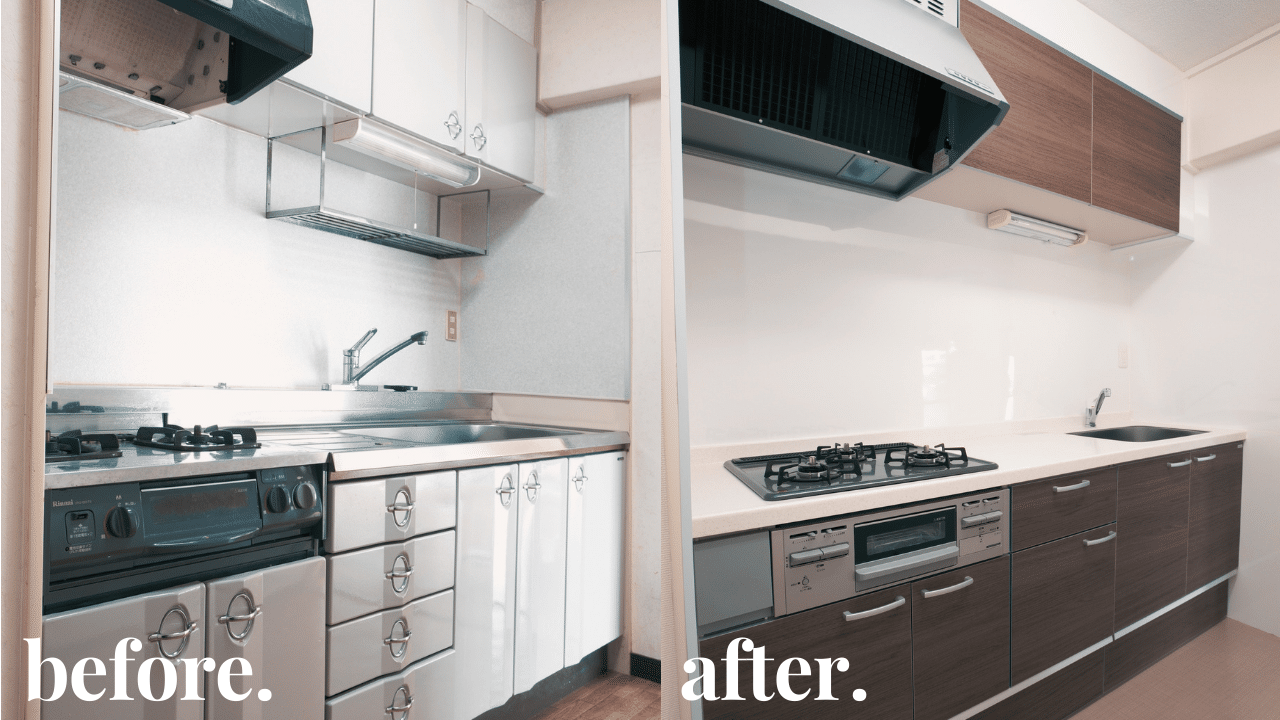So, you got some quotes for remodeling your kitchen.. and now you’re saying, “where does all the money go?” I feel you. Kitchen remodeling costs add up fast. And remodeling costs are inflating quickly with a combination of a labor shortage and material shortage compounding each other.
Here’s a general breakdown of the common factors that will come into play as you start this home improvement project:
This breakdown assumes that you are not changing the floor plan and/or relocating any walls/windows. That two factors will add substantial costs above the numbers we estimate in this post.
Kitchen Remodel Cost Breakdown

Disclaimer: Now that we’ve covered a rough estimate of an average kitchen remodel project, let’s look at some ballpark numbers.
This will give you an idea if you’re overspending or underspending on a specific kitchen fixture.
Cabinetry: 30-35%
In most cases, kitchen cabinets take up the majority of your budget. Case in point: custom-made, quality cabinets are handcrafted— so the labor process is more intensive. As such, prepare to set aside at least 35% of your budget on cabinets. Other factors that may affect this estimate include the number of cabinets you need, style, and upper cabinets vs. open shelves.
Labor & Installation: 15-20%
Given that a kitchen remodel project is labor-intensive, paying a professional to handle the task is another essential consideration to keep in mind.
Some homeowners may exceed the 20% allocation for professional labor fees. To avoid running short, you may want to prepare an additional 5% (or more) just so to address any unexpected contingencies. Don’t forget to talk to your local contractor about processing orders before the project begins.
For your reference, here are some of the most common unexpected costs that may hike your contractor’s service fees:
Countertops: 10-15%
The next significant expense to consider in your kitchen remodel cost breakdown is countertops. Most homeowners choose between granite and quartz material for their kitchen countertops, though these options will cost you more.
Cost-effective choices include concrete, solid surfaces, and stone countertops. Here are some other factors to keep in mind which may hike the price of your kitchen countertops:
Mechanical Components: 10-15%
The background components of your kitchen, such as electrical, plumbing, and HVAC work, can also be another significant expense to consider in setting aside the proper project budget. Homeowners who want to change the existing kitchen layout or remove/add new walls may need to prepare for additional expenses accordingly.
If you’re thinking about any of the following, it’s recommended that you prepare your budget:
Appliances: 10%
Allocating 10% for kitchen appliances is the bare minimum estimate if you choose quality appliances. But this figure may be less if you plan to keep some of your existing appliances (especially the refrigerator).
Some homeowners may need to allocate over 30% of their total project budget on appliances if they opt for state-of-the-art units featuring innovative technology and other features. Other factors that may hike the cost of kitchen appliances are as follows:
Finishing Touches/Miscellaneous: 5-10%
Lastly, you will need to save at least 5% of the budget for miscellaneous or finishing touches. Many homeowners seem to overlook this element, but these last-minute additions are the ones that will pull the result together.
These include items such as:
Recommended Kitchen Remodel Budget by the NKBA
For your reference, the National Kitchen and Bath Association (NKBA) published a recommendation for a standard kitchen remodel project so you can prepare your budget accordingly. This means you’ll need to budget around 15 to 20% of your home’s value on your kitchen makeover.
For instance:
For a $250,000 home |
|---|
$38,500 to $50,000 kitchen remodel budget |
For a $500,000 home |
|---|
$76,000 to $100,000 kitchen remodel budget |
But this shouldn’t be taken as the final cost for your home improvement projects as several factors will come into play. Remember, no one size fits all when it comes to calculating the budget you need for your dream kitchen remodel. (Related: Kitchen Remodel Cost Per Square Foot: We Break It Down)
Once you determine your desired budget, prepare at least 10 to 25% more (if possible) to address the surprises. You can achieve your dream kitchen set-up within your budget through proper planning and research!
When done correctly, a kitchen remodel can improve the look of your living space and increase the value of your property. Not to mention, it will also benefit your day-to-day living. Win-win situation, if you ask us!
Is Remodeling My Kitchen a Good Investment?
For many potential buyers, especially avid home cooks, your kitchen can either make or break a sale. Research has found that about 83% of investment into your kitchen is recouped in equity making it one of the best investments in home improvement.
Ensuring that you have a state-of-the-art, modern kitchen can attract more buyers and possibly drive the market price of your home further. The best part is that you don’t have to break the bank to remodel a kitchen. Even a tiny kitchen makeover can give you excellent ROI.
Think of your kitchen as more than just an investment. It’s a living space where you prepare your food and entertain guests visiting over— so why not design a kitchen layout that you can be proud of?
Final Thoughts
Figures on the internet merely serve as a ballpark in determining the total costs for your kitchen remodel project. (Related: Kitchen Remodeling: A Cost & Consumer Guide)
You’ll be surprised at how the actual numbers can vary in real life, depending on multiple factors. As such, talk to your contractor about prices (and any other hidden fees), so you can prepare your budget accordingly.
We recommend sticking to a budget and preparing for a detailed cost breakdown as much as possible. This will allow you to stretch your kitchen remodel dollars and prioritize the things in your kitchen (design, functionality) that you pay most importance to.
